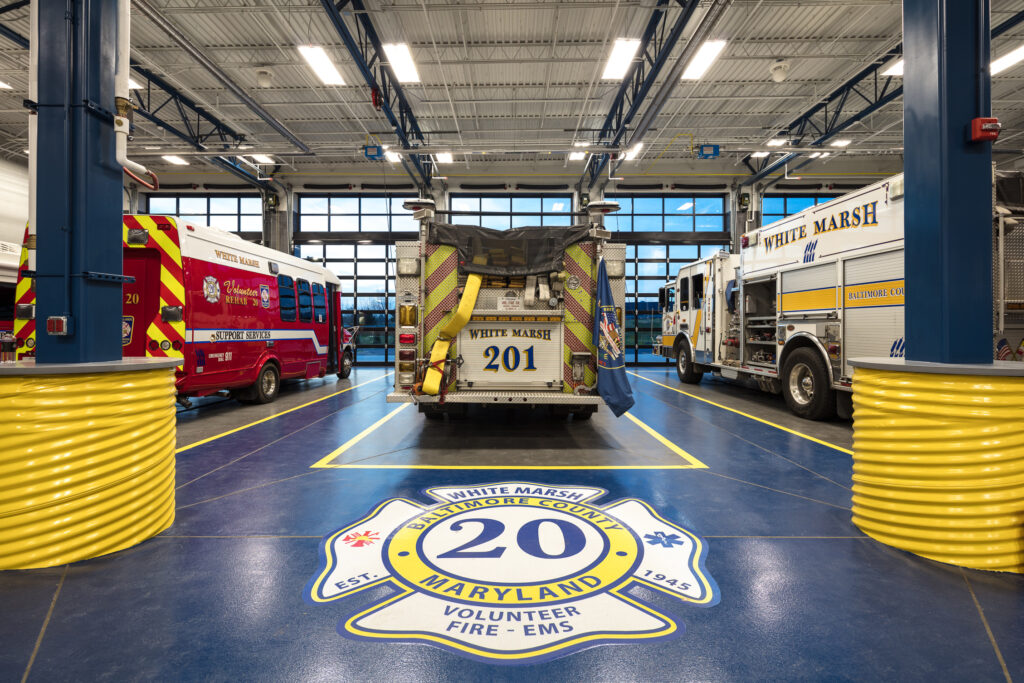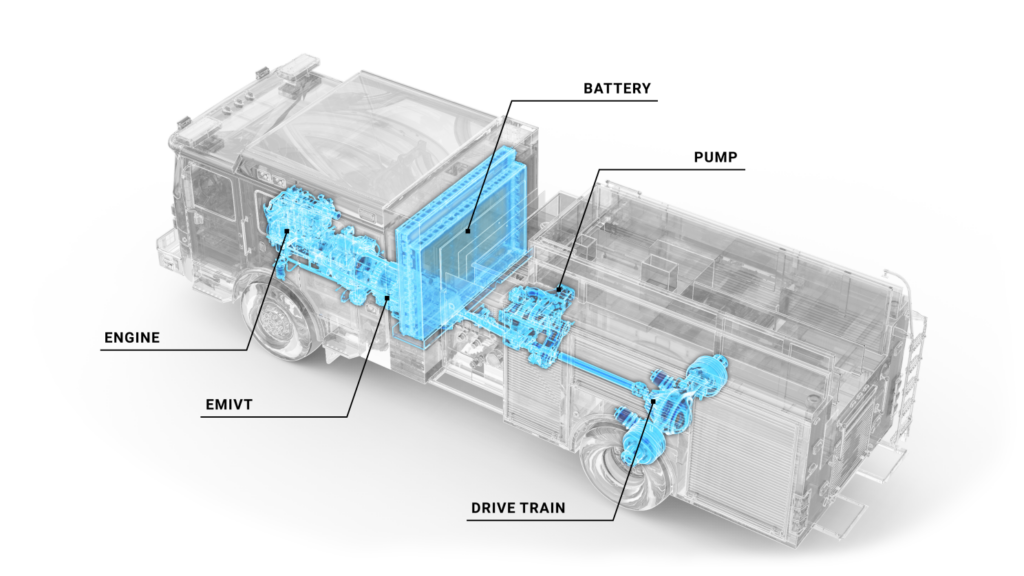Written by Rob Manns, AIA, Principal Architect | MW Studios

We’ve all heard the saying…“200 years of tradition unimpeded by progress.” When it comes to fire apparatus and station design, that old proverb couldn’t be further from the truth. Within 200 years, bucket brigades gave way to horse-drawn steamers. Steamers and the 1932 American LaFrance now adorn museums and fire station lobbies, while departments across the country rely on diesel-driven engines and ladders. The reality is technology in the fire service is changing at an unprecedented rate, and the next chapter is already here.
For over a decade, as the electric vehicle (EV) increasingly dominates the road, departments have adapted and learned how to fight the unique and challenging circumstances surrounding their existence. As EV apparatus continues gaining traction, new challenges will need to be addressed, and innovative solutions will be brought to market. The shift from diesel and gas to EV is already directly impacting the design and construction of stations. As departments plan to build new stations or renovate old ones, it’s crucial to understand the implications of Electric Apparatus on design requirements and construction costs.
DESIGN AND CONSTRUCTION IMPACT
When evaluating the impact on the space requirements and the electrical infrastructure associated with deploying EV apparatus, it’s essential to understand where the industry is currently positioned regarding technological development. For example, the bus transportation industry has been at it for considerably longer, producing more EV vehicles than any EV apparatus manufacturer. At the time of this writing, some EV bus manufacturers have brought vehicles to market that boast more than 700 kWh worth of energy. By contrast, most electric apparatus use small battery packs. Most pieces of apparatus leverage batteries with a 150-200 kWh capacity requiring 300-amps and a 480-volt three-phase electrical service.
In short, the EV apparatus is still in the early phases of a technology adoption curve. But that doesn’t mean we can’t forecast what the future might require. As apparatus manufacturers catch up with bus transportation, we should expect engines and trucks to come to market exceeding 600 kWh capacity. With that will come longer ranges and quicker charging capabilities, thus requiring an even more significant electric service than today’s EV apparatus demand.
For comparison purposes, a “non-EV ready” 20,000 SF four-bay station might require between 800-1200 amps of service. The same station, fully equipped for a fleet of 600 kWh+ EV apparatus, might require as much as 2,500 amps. The power demands associated with such apparatus, which include three-phase high-voltage, high amperage, electrical service are costly and may not be readily available in rural areas. Suitable back-bone infrastructure should be less of a problem for new or renovated stations in urban areas; however, it may be some time before the electrical grid and transmission lines in rural areas can meet such demands.

Further, when it comes to design and construction, the gear associated with EV-ready stations requires more robust equipment clearances, fire ratings, and exiting requirements. Suppose you are planning a new station but aren’t ready to go in the direction of EV apparatus. In that case, you may still want to consider providing additional conduit sleeves and up-sizing the electric room with sufficient egress for future electrical expansion. Planning for the future will eliminate the necessity for future additions and simplify the upgrade process down the road.
Finally, we must ask, while most EV apparatus vehicles today are equipped with reserve Diesel Internal Combustion Engines, will that design practice continue as battery capacities increase? If not, what new performance requirements should we expect from emergency backup generators if the station experiences power failure?

Pierce Volterra Schematic
SPRINKLER SYSTEMS & LIFE SAFETY
The electrolyte in lithium-ion cells is flammable. The heat produced from a short or another source can create exothermic reactions and release oxygen. As such, Lithium-Ion Batteries have the potential to create all the necessary conditions to develop and sustain a fire. As seen in countless EV fires, the conventional suppression method for an EV fire is to flood the battery with a tremendous amount of water. The volume of water required to contain a battery fire far exceeds the typical capacity of a sprinkler system designed for a conventional apparatus bay, which is typically classified as an ordinary hazard.
EVs are generally safe, with the NTSB reporting that EVs are 60 times less likely to catch fire than internal combustion engines. However, as a mission-critical facility, it is paramount to protect against the low-frequency, high-risk events that can cripple the ability to provide emergency service. Commonly in the news, we’ll hear about crews expending countless hours and thousands of gallons of water to finally extinguish a typical four-passenger EV that has undergone thermal runaway. When considering the size of the battery system used in passenger vehicles compared to fire apparatus, it’s not difficult to imagine that the demand for staffing and water can exponentially increase.
New technology often creates new challenges and innovative solutions. After all, if it weren’t for the space program, we might not still see Velcro in use. Although the concept of electric vehicles is no longer fresh, the increased adoption and capabilities of the technology have created new challenges in the design and construction industry. NFPA and other regulatory authorities have recently started developing standards and testing to address this issue of automatic fire suppression. There is currently no explicit code, standard, or path prescribing how to protect a fire station and its occupants from an EV apparatus fire. While prescriptive standards are in development and testing, it could be several years before we see design requirements propagate throughout various codes and standards and ultimately adopted by local jurisdictions.
In the event of an incident, if sufficient sprinkler protection does not exist, significant battery involvement is likely to occur. A battery fire can continue to develop, potentially resulting in a thermal runaway as the fire cascades into adjacent cells, thus resulting in an uncontrolled fire. Since batteries are typically mounted to the chassis and located within a shell, even water produced from a more robust higher-hazard sprinkler system won’t likely suffice for extinguishment. Nonetheless, a higher volume of water would be necessary to cool the battery and surrounding elements as the thermal runaway dissipates. In this instance, the overarching goal would be to mitigate the risk of igniting adjacent apparatus, minimize building damage, afford sufficient time for the building to be evacuated, and grant the department a fighting chance to engage rapidly in targeted suppression efforts.

THE FUTURE OF HEALTH SAFETY & WELLNESS
As many departments across the country still clamor to find funding to address diesel exhaust within the bays, one must question the future outlook on health safety and wellness. Will the roaring sounds of diesel engines leaving the station and flooding the bays with diesel particulates give way to the quiet humming of EV apparatus? Will the proverbial hot zone not be so hot? Will direct source capture hoses and HEPA filtration systems be replaced with more robust fire protection and electrical chargers? For a period, stations will likely have diesel, gas, and EV vehicles in service. But, as technology continues to evolve, acquisition costs will become more reasonable, and adaptation challenges will be resolved. Within the life expectancy of a new fire station or even a major renovation, we should expect to see EV take the lead and, consequently, make significant contributions to safer and healthier fire stations.
WHAT TO CONSIDER IN THE PLANNING PROCESS?
Fire stations are often generational investments. If properly planned, they should serve their communities for decades to come. For now, departments, architects, and engineers must know the current and potential future risks. Just because a department may be planning a station for an all-fossil-fuel fleet today doesn’t mean that 15 years from now, they won’t be operating an all-EV Fleet. Whether designing a new station or simply replacing existing apparatus with EV, one should certainly engage their local life safety officials in the early stages of the planning process to develop an acceptable plan to mitigate the risk of loss of life and property. As you begin to evaluate purchasing electric apparatus or planning a capital construction project for a station, here are some things you may consider asking yourself:
- If your department is planning a new station or preparing for the adoption of EV apparatus, have you considered future proofing or upgrading your fire suppression system?
- Are you planning to integrate high-challenge firewalls that separate the bays from occupied station portions?
- Did you think about strategically integrating wall-mounted handlines that might make suppression (and daily bay clean-up) easier should things go wrong?
- Is your electric infrastructure sized for the more powerful and electricity-hungry apparatus that will come in the future?
- If your department doesn’t have sufficient municipal water service, how will the increased sprinkler water demand impact holding tank and fire pump requirements?
- Does your region have the necessary power grid and infrastructure to support such an endeavor? If not, when will it come? If so, as EV technology becomes more prevalent, will this infrastructure still be suitable years from now as demand continues to increase?
- Should you plan ahead by allowing enough room for future electrical service upgrades?
- Is a photovoltaic array (solar panels) a suitable solution for your region to help offset the cost of electricity?
- Firefighters are resourceful. EV fires are stubborn. Have you considered any creative methods and procedures in which you might remove an involved piece of apparatus from your station to mitigate the damage to the building?

Rob Manns is a principal architect with MW Studios in Baltimore, Maryland. He has more than 20 years of experience in the design of public safety facilities and has been recognized more than a dozen times for fire station design excellence.
Excerpts of this Article have been published by FireHouse Magazine.